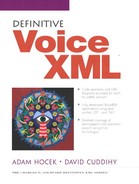3.30. meta
| Element type | meta |
| Attributes | content | http-equiv | name |
| Parents | vxml |
| Children | None. |
| Description | The meta element specifies a property and assigns a value to it. It is used to provide additional information about a VoiceXML document that can be used by search engines or other software. The interpreter can use this information to know where to send debugging information (a common implementation is to email error messages to the email address specified with the maintainer meta field). Another use of meta-data is to include client-side information as part of an HTTP response header (this can be used by the client-side cache to know when the document expires and it is necessary to obtain a fresh copy of the document). |
DTD
<!ELEMENT meta EMPTY > <!ATTLIST meta name NMTOKEN #IMPLIED content CDATA #REQUIRED http-equiv NMTOKEN #IMPLIED >
Language model

Attributes
content : CDATA
The content of the meta field specified by this element.
http-equiv : NMTOKEN
The name of an HTTP response header. Either http-equiv or name are specified, never both.
name : NMTOKEN
The name of the meta field specified by this element.
Children
None.
Examples
Example 3-36. Using meta
<?xml version="1.0" encoding="iso-8859-1"?>
<vxml version="2.0">
<meta name="author" contents="Joe Schmoe"/>
<meta name="copyright" contents="(c)2002. SchmoeCorp."/>
<meta name="description" contents="A Voice E-Mail gateway."/>
<meta name="keywords"
contents="E-Mail email voice voice-activated"/>
<meta name="maintainer" contents="[email protected]"/>
<meta name="robots" content="noindex, nofollow"/>
<!-- the rest of the VoiceXML application goes here... -->
</vxml>
|
..................Content has been hidden....................
You can't read the all page of ebook, please click here login for view all page.
